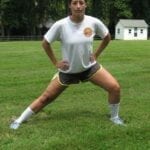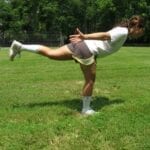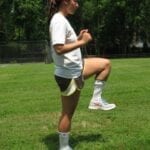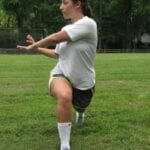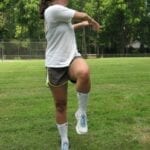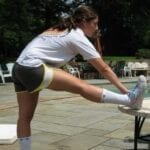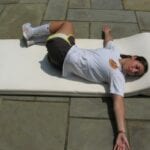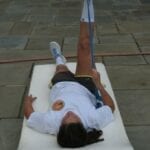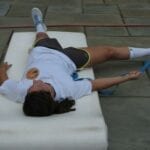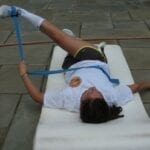Written by Danielle Scheinman, MPH, CHES
July 22, 2013
As part of the warm up period, it’s a good idea to stretch. Generally, before exercise, “dynamic” stretching is better and afterwards, “static” stretching is preferred. Dynamic stretching involves warming up the muscles with gentle, gradual moves, without a prolonged hold. If you try to maximally stretch a ‘cold’ muscle, you’re more likely to induce a tear. Just as the elastic in a rubber band gets less flexible and more likely to tear with age and in the cold, so do some of the fibers in our bodies. If we stretch gradually at the beginning of our exercise, and further at the end, we should maintain better flexibility and minimize the risk of a tear or strain.
An example of a dynamic stretch, would be bringing your arms in front of you, as if hugging a giant beach ball, then bringing them back, drawing your shoulder blades together behind you, and repeating that 8-10 times. This movement would be both warming up and stretching your chest and upper back muscles by initiating and stretch and contraction. Another would be stepping to the right with your right leg, while lifting your left arm overhead toward your right side to open up the rib cage. Repeat with your left leg and right arm. Multiple other routines should take 5 minutes or so, until you feel ready to exercise. The idea of a warm up, whether primarily stretching or aerobic is intended to alert the muscles that you are about to challenge them. The adjustments that are made include a redistribution of blood to these working muscles to provide oxygen, and an increase in muscle temperature to allow optimal functioning of the muscular proteins.
A vigorous exercise session can be followed by walking or other cool down to allow your heart rate to decrease to the point where you feel comfortable standing still. A gradual cool down also decreases delayed muscle soreness by flushing out the lactic acid from worked muscles while redirecting blood flow back to central circulation. At this point, you can do static stretches, holding a position for 20-30 seconds or so. These could include some of the same ones as above, but with a hold. The simplest version would be touching your toes – or as close as you can get without feeling pain in the hamstrings (the large muscles in the back of your thighs). They might include a ‘figure 4’ stretch of the lower body, lunges, torso stretches, or many others. Make sure you take good deep breaths while you do these. You might feel like you can go a little further with each breath. In the long run, these should help you stay more flexible and less apt to tear a tendon or ligament.
Including mat pilates or yoga as one or more of your weekly workout sessions will provide you with many stretches. You’ll have the added advantage of working on your balance (see Dr. Seidelman’s Balance entry) – another insidious problem as you get further from your 20’s! With any of these, just keep in mind, listen to your body — work hard, but NO PAIN!
Lastly, the greatest function of stretching is to relieve a cramp! There are sensors in the muscle that tell your brain when a muscle is being stretched. At a certain point these sensors activate to ensure the muscle is not stretched so far to cause a tear. When such signals are sent, the brain in turn tells the muscle to relax. In doing so, the cramp that you once had (an involuntary contraction of a muscle) will ultimately release. As with anything else, this is no quick fix. You might need to go through a few sets of stretching before the cramp really dissipates. A few sips of water might facilitate a muscle to relax by rehydrating the muscle, and indirectly reestablishing fluid balance.
Some of the images below are examples of stretches that can kickstart your workout! Try to complete five repititions one each leg, moving slowly and with control.
Tags:





